For the second year in a row, Intel conducted its annual open source community survey designed to capture a clearer understanding of the challenges open source developers are facing today, and the ways Intel can better support the community. The survey, which ran from December 2023 through January 2024, received 666 responses, enabling Intel to donate $3,330 to Outreachy, an incredible internship program supporting diversity in open source. It also gave us insights into where developers are struggling, what matters most to them, and how Intel can improve as a partner and active contributor to the community.
While the results may not be surprising to those of you in the trenches doing the work — which more of you are doing more frequently according to the survey—it’s important to shine a light on them so we can continue to advance the industry together. Let’s look at what we found.
The Male Majority
This year’s respondents mostly self-identified as “male” (79%) in their late 30s, with 33% based in the United States and 67% internationally. Respondents came from a diverse range of industries, with—to absolutely no one’s surprise— software development and technology being the most represented.

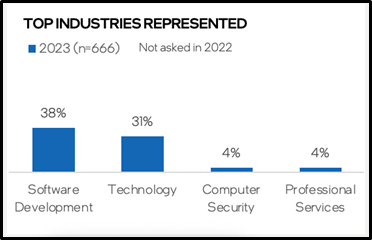
The least surprising data from our survey results show that most respondents self-identify as male, hail from outside of the United States, and work in either software development or tech.
The number of respondents self-identifying as “female” was significantly down from last year—only 7% compared to last year’s 15%. That’s a troubling and disappointing number in an industry that has long struggled with diversity, equity, and inclusion. And while tech in general notoriously lacks gender diversity, the problem is even worse in open source. Researchers in the computer science department at Idaho State University did an in-depth analysis of over 10 thousand developers’ nearly 21 million commits to more than 81 million different projects and learned that the proportion of female contributors is only 7.5% or lower, with women making fewer commits to the projects compared to male contributors.
People keep asking, where are the women in open source? But a better question might be, what can we do — or perhaps stop doing — to get them more involved?
Feeling the Burn
While employee stress is at an all-time high, open source maintainers are feeling it more than most. The majority of survey respondents (45%) cited maintainer burnout as their top challenge, with documentation and onboarding (41%) coming in at a close second. Much has been written about maintainer burnout, including Tidelift’s 2023 survey of open source maintainers, which found that almost 60% of maintainers have quit, or considered quitting, maintaining one of their projects due to a slew of issues, including competing priorities, burnout, lack of interest, money, time, and being forced to field too many demands from users.
How can we help maintainers reduce stress? Ashwin Ramaswami offers some suggestions, but you may also want to check out these tips for self-care and avoiding burnout.
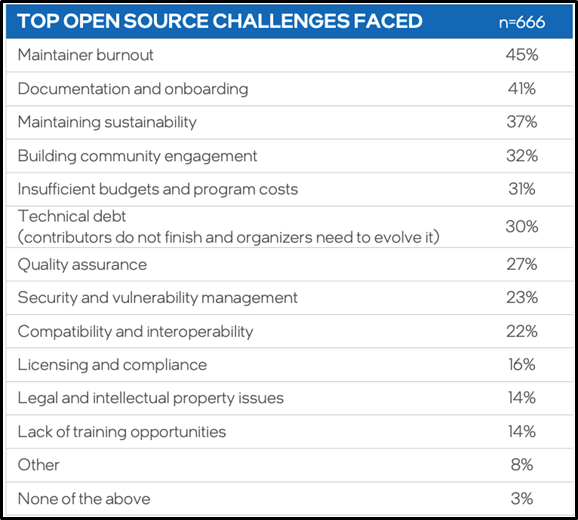
Respondents face many open source challenges with maintainer burnout being at the top of the list. Open source maintainers, hang in there. We appreciate you!
Nevertheless, They Persisted
Despite the toll it can sometimes take, the commitment to open source remains strong, with about 4 out of 10 respondents contributing to open source projects at least once a week and spending more time doing so than in the past. Significantly more respondents have contributed to open source projects compared with last year (91% vs 84%).
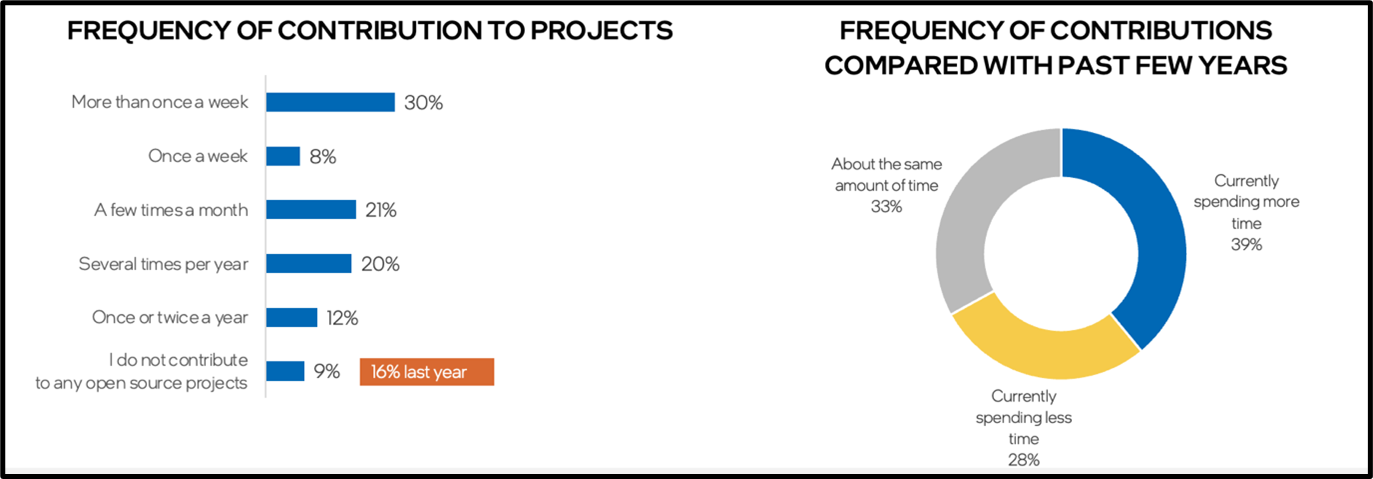
About 4 out of 10 respondents contribute to open source projects at least once a week and more are spending time contributing to open source projects than in the past.
Let Me See Your License
When choosing to get involved in a project, most respondents said an acceptable open source license was most important followed closely by maintainer responsiveness. Interestingly, the license was far more important to our U.S respondents than our international respondents, who found licenses and maintainer responsiveness to be equally critical.
Understanding open source licensing is important because the license impacts how you and others will be able to use your work and can also protect you from potentially unpleasant (and expensive) legal issues.
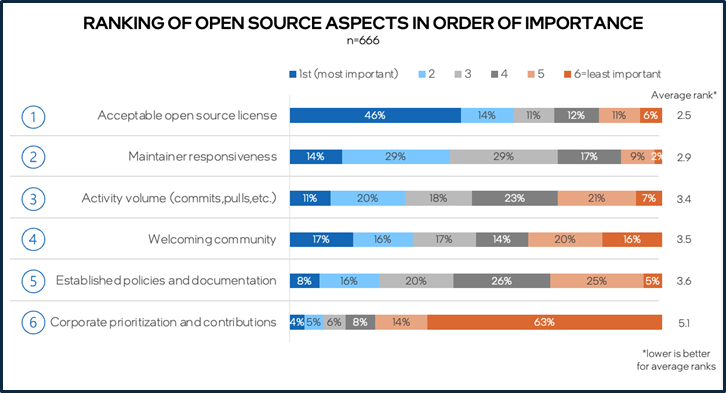
An acceptable license is most important to respondents when choosing to get involved in an open source project, but maintainer responsiveness comes in a close second. Perhaps another reason maintainers are feeling burnt out.
Everyone Loves Linux
Respondents were twice as interested in Linux over the 2nd ranked project, Rust, which makes sense since Linux is one of the world’s best-known and most-used operating systems. Full disclosure, Intel was a founding member of the Linux Foundation and has been the top contributor to the Linux kernel for more than 15 years. Intel is also a top 10 contributor to both Kubernetes and OpenJDK and a top contributor to PyTorch, which many respondents claimed interest in for our survey.
Respondents also showed interest in a large selection of “other” open source projects with over 200 write-ins for that category documenting interest in projects not included in our multiple-choice list. This large write-in pool shows the extensive breadth and scope of the open ecosystem, which only continues to expand.
In Perforce’s 2024 State of Open Source Report, 95% of respondents say they’ve increased or maintained their use of open source in 2023 (33% of those significantly so) citing “no license cost” and “overall cost reduction” as the top reasons for adopting open source.
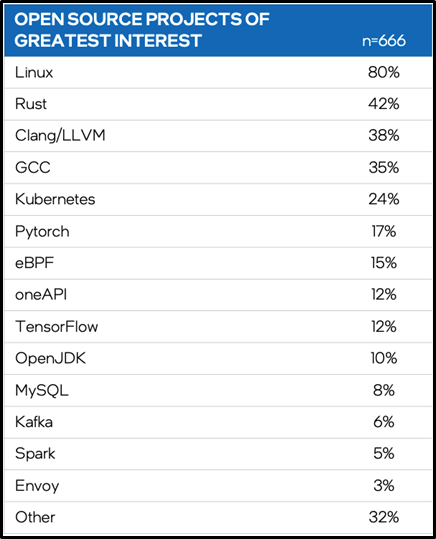
Respondents are twice as interested in Linux open source projects over the 2nd ranked project, Rust. Nonetheless, there is interest in many open source projects and too many to list here.
Open Source on the Road
Where should you go to learn from and meet with folks who are active in the open ecosystem? If you can make it to Brussels, you might want to check out FOSDEM, the top event for learning more about new open source solutions and technologies. For U.S.-based folks, you might find it easier to attend the second most popular event for respondents, Open Source Summit, which Intel is sponsoring this year. We hope to see you there!
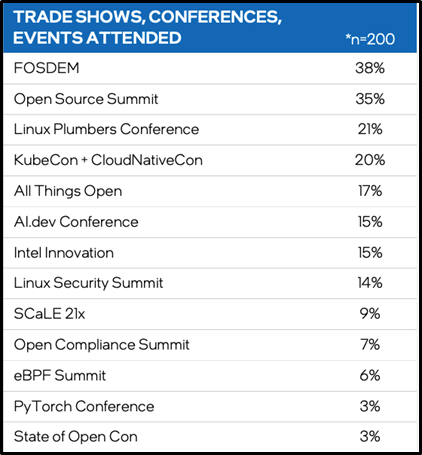
There’s no shortage of great open source conferences, but if you had to pick one, most of our survey respondents would go to either FOSDEM or Open Source Summit.
Open Source + AI = Innovation
A whopping 82% of respondents consider open source to be highly important to innovation in AI and those who are actively using AI consider open source to be even more important to AI than those who aren’t using it (94% vs 74%).
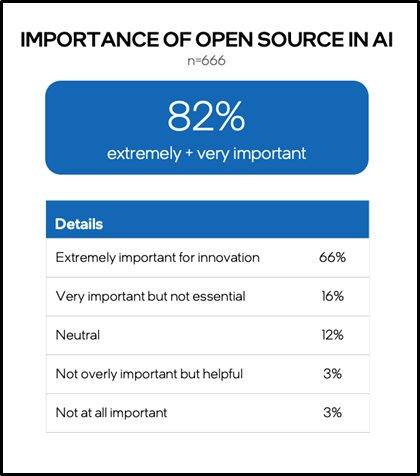
Many of you consider the role of open source in AI to be extremely or very important.
Four out of 10 respondents are using AI tools in their workflow, with the majority focusing on generative AI, AI optimizations, and responsible AI. While most of us have at least experimented with generative AI tools, the challenge is to effectively incorporate them into our workflow to make us more productive without putting the business at risk. For those planning to learn more about explainable AI this year, check out Ezequiel Lanza’s What is Explainable AI (XAI) and Why Does it Matter?
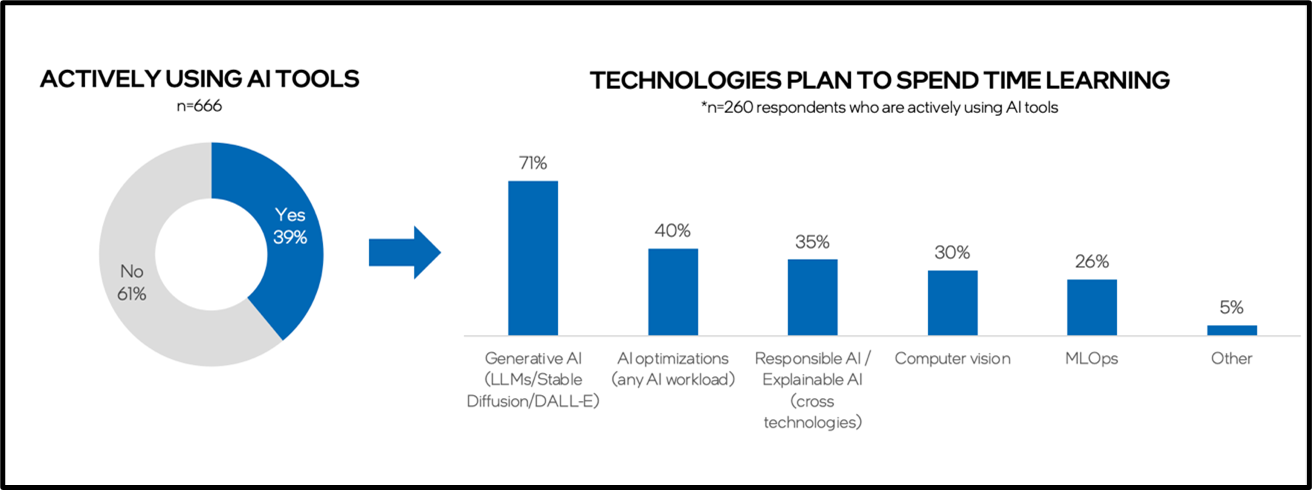
The majority of respondents aren’t using AI in their workflow yet, but 71% plan to spend time learning about generative AI so expect that number to go up next year.
Tried and Trusted
We were happy to learn that 3 out of 4 of respondents have a favorable opinion of Intel’s participation in open source—a significant increase over last year. But we know we can do better. Respondents told us that too. Based on their comments, we understand we have work to do getting the word out about our community contributions and maintaining and committing to projects. We’re looking forward to making great progress in the year ahead.
About the Author
Nikki McDonald, Content Manager, Intel Open Ecosystem
Focused on educating and inspiring developers for over a decade, Nikki leads the strategy and execution for open source-related content at Intel. Her mission is to empower our open source community to grow their skills, stay informed, and exchange ideas. An avid reader, you’ll never find her without her Kindle. Connect with her on LinkedIn and X.
